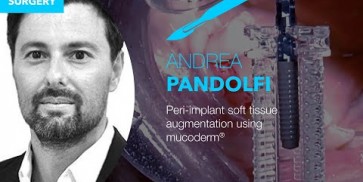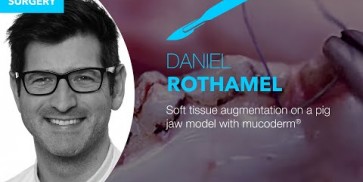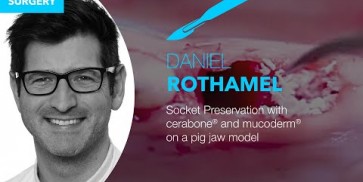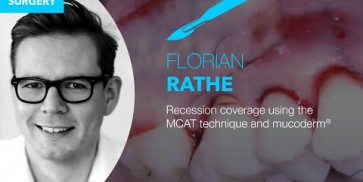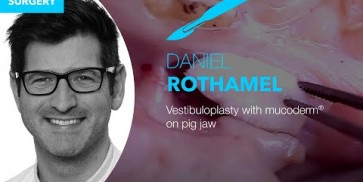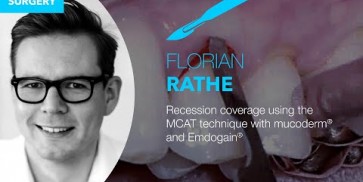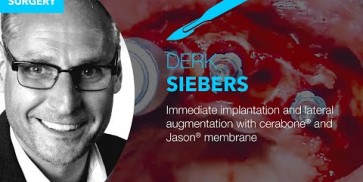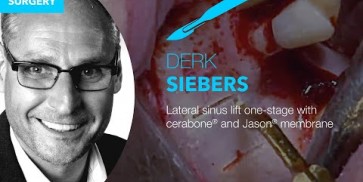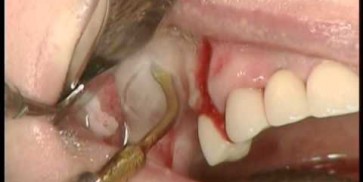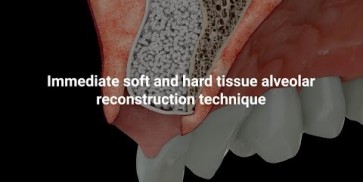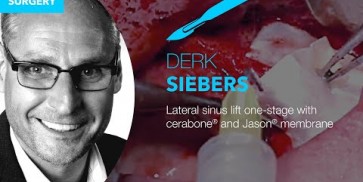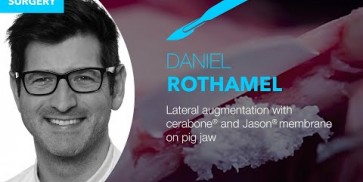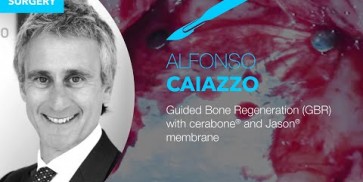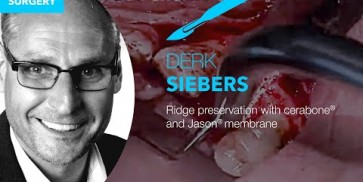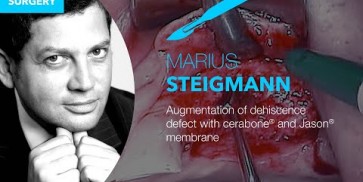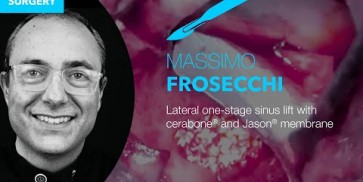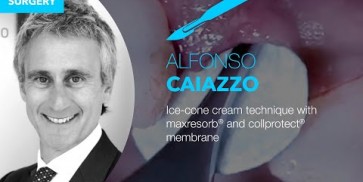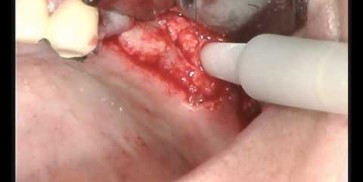Small tile blue
mucoderm®
After placement, the patient’s blood infiltrates the mucoderm® graft through the three-dimensional soft tissue network, bringing host cells to the soft tissue graft surface and triggering the revascularization process. A significant revascularization may begin after the implantation depending on the health condition of the patient. mucoderm® offers a safe alternative to autologous connective tissue, suitable for a diverse range of soft tissue grafting indications.
|
Immobilization
Contact of mucoderm® with the periosteal wound bed and immobilization should be ensured by suturing the matrix to the periosteum using single-interrupted- or all-crossed sutures
Immobilization
Contact of mucoderm® with the periosteal wound bed and immobilization should be ensured by suturing the matrix to the periosteum using single-interrupted- or all-crossed sutures
Immobilization
Contact of mucoderm® with the periosteal wound bed and immobilization should be ensured by suturing the matrix to the periosteum using single-interrupted- or all-crossed sutures
Immobilization
Contact of mucoderm® with the periosteal wound bed and immobilization should be ensured by suturing the matrix to the periosteum using single-interrupted- or all-crossed sutures
Immobilization
Contact of mucoderm® with the periosteal wound bed and immobilization should be ensured by suturing the matrix to the periosteum using single-interrupted- or all-crossed sutures
Immobilization
Contact of mucoderm® with the periosteal wound bed and immobilization should be ensured by suturing the matrix to the periosteum using single-interrupted- or all-crossed sutures
Avoid sharp edges
Cutting the edges of a shortly rehydrated matrix prevent damage of the gingival tissue during flap closure
Avoid sharp edges
Cutting the edges of a shortly rehydrated matrix prevent damage of the gingival tissue during flap closure
Avoid sharp edges
Cutting the edges of a shortly rehydrated matrix prevent damage of the gingival tissue during flap closure
Avoid sharp edges
Cutting the edges of a shortly rehydrated matrix prevent damage of the gingival tissue during flap closure
Avoid sharp edges
Cutting the edges of a shortly rehydrated matrix prevent damage of the gingival tissue during flap closure
Avoid sharp edges
Cutting the edges of a shortly rehydrated matrix prevent damage of the gingival tissue during flap closure
Tunnel technique
For the tunnel technique a prolonged, 10-20 min, rehydration time of the mucoderm® is recommended. Fixation of the matrix by single-interrupted- or allcrossed sutures is required.
Tunnel technique
For the tunnel technique a prolonged, 10-20 min, rehydration time of the mucoderm® is recommended. Fixation of the matrix by single-interrupted- or allcrossed sutures is required.
Tunnel technique
For the tunnel technique a prolonged, 10-20 min, rehydration time of the mucoderm® is recommended. Fixation of the matrix by single-interrupted- or allcrossed sutures is required.
Tunnel technique
For the tunnel technique a prolonged, 10-20 min, rehydration time of the mucoderm® is recommended. Fixation of the matrix by single-interrupted- or allcrossed sutures is required.
Tunnel technique
For the tunnel technique a prolonged, 10-20 min, rehydration time of the mucoderm® is recommended. Fixation of the matrix by single-interrupted- or allcrossed sutures is required.
Tunnel technique
For the tunnel technique a prolonged, 10-20 min, rehydration time of the mucoderm® is recommended. Fixation of the matrix by single-interrupted- or allcrossed sutures is required.
Gingival recessions
Exposure of the mucoderm® matrix should always be avoided in recession coverage procedures. Make sure that the repositioned flap completely covers the mucoderm® matrix. Achieving primary closure over the mucoderm® graft allows blood vessels to penetrate and incorporate the soft tissue graft material. Early exposure may lead to soft tissue graft failure.
Gingival recessions
Exposure of the mucoderm® matrix should always be avoided in recession coverage procedures. Make sure that the repositioned flap completely covers the mucoderm® matrix. Achieving primary closure over the mucoderm® graft allows blood vessels to penetrate and incorporate the soft tissue graft material. Early exposure may lead to soft tissue graft failure.
Gingival recessions
Exposure of the mucoderm® matrix should always be avoided in recession coverage procedures. Make sure that the repositioned flap completely covers the mucoderm® matrix. Achieving primary closure over the mucoderm® graft allows blood vessels to penetrate and incorporate the soft tissue graft material. Early exposure may lead to soft tissue graft failure.
Gingival recessions
Exposure of the mucoderm® matrix should always be avoided in recession coverage procedures. Make sure that the repositioned flap completely covers the mucoderm® matrix. Achieving primary closure over the mucoderm® graft allows blood vessels to penetrate and incorporate the soft tissue graft material. Early exposure may lead to soft tissue graft failure.
Gingival recessions
Exposure of the mucoderm® matrix should always be avoided in recession coverage procedures. Make sure that the repositioned flap completely covers the mucoderm® matrix. Achieving primary closure over the mucoderm® graft allows blood vessels to penetrate and incorporate the soft tissue graft material. Early exposure may lead to soft tissue graft failure.
Gingival recessions
Exposure of the mucoderm® matrix should always be avoided in recession coverage procedures. Make sure that the repositioned flap completely covers the mucoderm® matrix. Achieving primary closure over the mucoderm® graft allows blood vessels to penetrate and incorporate the soft tissue graft material. Early exposure may lead to soft tissue graft failure.
Straumann® Emdogain®
Gingival recessions may be treated using mucoderm® and Straumann® Emdogain® together in a single approach. Potential benefits of adding Straumann® Emdogain® to a root coverage procedure with mucoderm® are described in "Collagen matrix and enamel matrix derivative". Make always sure that Straumann® Emdogain® is applied all over the root surfaces before the mucoderm® matrix is placed over the roots.
Straumann® Emdogain®
Gingival recessions may be treated using mucoderm® and Straumann® Emdogain® together in a single approach. Potential benefits of adding Straumann® Emdogain® to a root coverage procedure with mucoderm® are described in "Collagen matrix and enamel matrix derivative". Make always sure that Straumann® Emdogain® is applied all over the root surfaces before the mucoderm® matrix is placed over the roots.
Straumann® Emdogain®
Gingival recessions may be treated using mucoderm® and Straumann® Emdogain® together in a single approach. Potential benefits of adding Straumann® Emdogain® to a root coverage procedure with mucoderm® are described in "Collagen matrix and enamel matrix derivative". Make always sure that Straumann® Emdogain® is applied all over the root surfaces before the mucoderm® matrix is placed over the roots.
Straumann® Emdogain®
Gingival recessions may be treated using mucoderm® and Straumann® Emdogain® together in a single approach. Potential benefits of adding Straumann® Emdogain® to a root coverage procedure with mucoderm® are described in "Collagen matrix and enamel matrix derivative". Make always sure that Straumann® Emdogain® is applied all over the root surfaces before the mucoderm® matrix is placed over the roots.
Straumann® Emdogain®
Gingival recessions may be treated using mucoderm® and Straumann® Emdogain® together in a single approach. Potential benefits of adding Straumann® Emdogain® to a root coverage procedure with mucoderm® are described in "Collagen matrix and enamel matrix derivative". Make always sure that Straumann® Emdogain® is applied all over the root surfaces before the mucoderm® matrix is placed over the roots.
Straumann® Emdogain®
Gingival recessions may be treated using mucoderm® and Straumann® Emdogain® together in a single approach. Potential benefits of adding Straumann® Emdogain® to a root coverage procedure with mucoderm® are described in "Collagen matrix and enamel matrix derivative". Make always sure that Straumann® Emdogain® is applied all over the root surfaces before the mucoderm® matrix is placed over the roots.
Please Contact us for Literature.
Jason® membrane
Due to the unique production process, the superior properties of the native pericardium are preserved during the extensive cleaning procedure that is applied for the production of Jason® membrane. Therefore, Jason® membrane shows a natural honeycomb-like, multilayered collagen structure with an increased content of collagen type III leading to a remarkable tear resistance to and a slow degradation of Jason® membrane. This ensures a natural long barrier function, making the Jason® membrane our recommended choice particularly for large augmentative procedures.
|
Rehydration
The Jason® membrane can be applied dry or pre-hydrated in sterile saline solution or blood from the defect. The initial placement of the dry membrane with subsequent application of the graft material is particularly advantageous for lateral augmentations. After rehydration the membrane can be folded over the defect.
Rehydration
The Jason® membrane can be applied dry or pre-hydrated in sterile saline solution or blood from the defect. The initial placement of the dry membrane with subsequent application of the graft material is particularly advantageous for lateral augmentations. After rehydration the membrane can be folded over the defect.
Rehydration
The Jason® membrane can be applied dry or pre-hydrated in sterile saline solution or blood from the defect. The initial placement of the dry membrane with subsequent application of the graft material is particularly advantageous for lateral augmentations. After rehydration the membrane can be folded over the defect.
Rehydration
The Jason® membrane can be applied dry or pre-hydrated in sterile saline solution or blood from the defect. The initial placement of the dry membrane with subsequent application of the graft material is particularly advantageous for lateral augmentations. After rehydration the membrane can be folded over the defect.
Rehydration
The Jason® membrane can be applied dry or pre-hydrated in sterile saline solution or blood from the defect. The initial placement of the dry membrane with subsequent application of the graft material is particularly advantageous for lateral augmentations. After rehydration the membrane can be folded over the defect.
Rehydration
The Jason® membrane can be applied dry or pre-hydrated in sterile saline solution or blood from the defect. The initial placement of the dry membrane with subsequent application of the graft material is particularly advantageous for lateral augmentations. After rehydration the membrane can be folded over the defect.
Fixation
Jason® membrane exhibits a remarkable multi-directional tear resistance. Therefore, it can easily be pinned, sutured or even screwed without rupturing.
Fixation
Jason® membrane exhibits a remarkable multi-directional tear resistance. Therefore, it can easily be pinned, sutured or even screwed without rupturing.
Fixation
Jason® membrane exhibits a remarkable multi-directional tear resistance. Therefore, it can easily be pinned, sutured or even screwed without rupturing.
Fixation
Jason® membrane exhibits a remarkable multi-directional tear resistance. Therefore, it can easily be pinned, sutured or even screwed without rupturing.
Fixation
Jason® membrane exhibits a remarkable multi-directional tear resistance. Therefore, it can easily be pinned, sutured or even screwed without rupturing.
Fixation
Jason® membrane exhibits a remarkable multi-directional tear resistance. Therefore, it can easily be pinned, sutured or even screwed without rupturing.
Exposure
Exposure of Jason® membrane should be avoided, since fast bacterial resorption significantly reduces the barrier function of the thin Jason® membrane. In case of an unstable soft tissue situation or if you expect a wound dehiscence to occur, it is recommended to cover the membrane with a Jason® fleece (where applicable, soaked in antibiotics) to protect the healing area. In case of a dehiscence the wound usually heals without complications by formation of free granulation tissue.
Exposure
Exposure of Jason® membrane should be avoided, since fast bacterial resorption significantly reduces the barrier function of the thin Jason® membrane. In case of an unstable soft tissue situation or if you expect a wound dehiscence to occur, it is recommended to cover the membrane with a Jason® fleece (where applicable, soaked in antibiotics) to protect the healing area. In case of a dehiscence the wound usually heals without complications by formation of free granulation tissue.
Exposure
Exposure of Jason® membrane should be avoided, since fast bacterial resorption significantly reduces the barrier function of the thin Jason® membrane. In case of an unstable soft tissue situation or if you expect a wound dehiscence to occur, it is recommended to cover the membrane with a Jason® fleece (where applicable, soaked in antibiotics) to protect the healing area. In case of a dehiscence the wound usually heals without complications by formation of free granulation tissue.
Exposure
Exposure of Jason® membrane should be avoided, since fast bacterial resorption significantly reduces the barrier function of the thin Jason® membrane. In case of an unstable soft tissue situation or if you expect a wound dehiscence to occur, it is recommended to cover the membrane with a Jason® fleece (where applicable, soaked in antibiotics) to protect the healing area. In case of a dehiscence the wound usually heals without complications by formation of free granulation tissue.
Exposure
Exposure of Jason® membrane should be avoided, since fast bacterial resorption significantly reduces the barrier function of the thin Jason® membrane. In case of an unstable soft tissue situation or if you expect a wound dehiscence to occur, it is recommended to cover the membrane with a Jason® fleece (where applicable, soaked in antibiotics) to protect the healing area. In case of a dehiscence the wound usually heals without complications by formation of free granulation tissue.
Exposure
Exposure of Jason® membrane should be avoided, since fast bacterial resorption significantly reduces the barrier function of the thin Jason® membrane. In case of an unstable soft tissue situation or if you expect a wound dehiscence to occur, it is recommended to cover the membrane with a Jason® fleece (where applicable, soaked in antibiotics) to protect the healing area. In case of a dehiscence the wound usually heals without complications by formation of free granulation tissue.
Shaping
Jason® membrane can be cut to the desired shape and size with a pair of scissors - while maintaining sterility. It may be helpful to use appropriate templates for defining the required size of the membrane.
Shaping
Jason® membrane can be cut to the desired shape and size with a pair of scissors - while maintaining sterility. It may be helpful to use appropriate templates for defining the required size of the membrane.
Shaping
Jason® membrane can be cut to the desired shape and size with a pair of scissors - while maintaining sterility. It may be helpful to use appropriate templates for defining the required size of the membrane.
Shaping
Jason® membrane can be cut to the desired shape and size with a pair of scissors - while maintaining sterility. It may be helpful to use appropriate templates for defining the required size of the membrane.
Shaping
Jason® membrane can be cut to the desired shape and size with a pair of scissors - while maintaining sterility. It may be helpful to use appropriate templates for defining the required size of the membrane.
Shaping
Jason® membrane can be cut to the desired shape and size with a pair of scissors - while maintaining sterility. It may be helpful to use appropriate templates for defining the required size of the membrane.
Placement
Jason® membrane has one rough and one slightly smoother surface. The smoother, fine structured side is marked „G“ at the top right corner and should be placed towards the gingiva. The rougher side should face the bone. However, there is no problem if the membrane is placed the other way around, since the long-term barrier function of the membrane will still provide sufficient protection for the regeneration site.
Placement
Jason® membrane has one rough and one slightly smoother surface. The smoother, fine structured side is marked „G“ at the top right corner and should be placed towards the gingiva. The rougher side should face the bone. However, there is no problem if the membrane is placed the other way around, since the long-term barrier function of the membrane will still provide sufficient protection for the regeneration site.
Placement
Jason® membrane has one rough and one slightly smoother surface. The smoother, fine structured side is marked „G“ at the top right corner and should be placed towards the gingiva. The rougher side should face the bone. However, there is no problem if the membrane is placed the other way around, since the long-term barrier function of the membrane will still provide sufficient protection for the regeneration site.
Placement
Jason® membrane has one rough and one slightly smoother surface. The smoother, fine structured side is marked „G“ at the top right corner and should be placed towards the gingiva. The rougher side should face the bone. However, there is no problem if the membrane is placed the other way around, since the long-term barrier function of the membrane will still provide sufficient protection for the regeneration site.
Placement
Jason® membrane has one rough and one slightly smoother surface. The smoother, fine structured side is marked „G“ at the top right corner and should be placed towards the gingiva. The rougher side should face the bone. However, there is no problem if the membrane is placed the other way around, since the long-term barrier function of the membrane will still provide sufficient protection for the regeneration site.
Placement
Jason® membrane has one rough and one slightly smoother surface. The smoother, fine structured side is marked „G“ at the top right corner and should be placed towards the gingiva. The rougher side should face the bone. However, there is no problem if the membrane is placed the other way around, since the long-term barrier function of the membrane will still provide sufficient protection for the regeneration site.
Please Contact us for Literature.
collprotect® membrane
The unique processing as well as the open-porous and the three-dimensional collagen structure of collprotect® membrane are the basis for its safe application in dental bone and tissue regeneration. Owing to its natural hemostyptic function, the membrane enables early wound stabilization, thus supporting the natural wound healing. The rough surface of collprotect® membrane facilitates a fast integration into the surrounding soft tissue.
|
Shaping
The membrane can easily be cut-to-size with scissors or a scalpel to fit the defect. It is recommended to cut the membrane in dry status prior to application, although shaping the membrane after rehydration is also possible.
Shaping
The membrane can easily be cut-to-size with scissors or a scalpel to fit the defect. It is recommended to cut the membrane in dry status prior to application, although shaping the membrane after rehydration is also possible.
Shaping
The membrane can easily be cut-to-size with scissors or a scalpel to fit the defect. It is recommended to cut the membrane in dry status prior to application, although shaping the membrane after rehydration is also possible.
Shaping
The membrane can easily be cut-to-size with scissors or a scalpel to fit the defect. It is recommended to cut the membrane in dry status prior to application, although shaping the membrane after rehydration is also possible.
Shaping
The membrane can easily be cut-to-size with scissors or a scalpel to fit the defect. It is recommended to cut the membrane in dry status prior to application, although shaping the membrane after rehydration is also possible.
Shaping
The membrane can easily be cut-to-size with scissors or a scalpel to fit the defect. It is recommended to cut the membrane in dry status prior to application, although shaping the membrane after rehydration is also possible.
Fixation
Normally, fixation is not necessary, because of the excellent ability of the collprotect® membrane to adhere to the underlying tissue as well as adapt to surface contours. However, the collprotect® membrane supports suturing and pinning if required.
Fixation
Normally, fixation is not necessary, because of the excellent ability of the collprotect® membrane to adhere to the underlying tissue as well as adapt to surface contours. However, the collprotect® membrane supports suturing and pinning if required.
Fixation
Normally, fixation is not necessary, because of the excellent ability of the collprotect® membrane to adhere to the underlying tissue as well as adapt to surface contours. However, the collprotect® membrane supports suturing and pinning if required.
Fixation
Normally, fixation is not necessary, because of the excellent ability of the collprotect® membrane to adhere to the underlying tissue as well as adapt to surface contours. However, the collprotect® membrane supports suturing and pinning if required.
Fixation
Normally, fixation is not necessary, because of the excellent ability of the collprotect® membrane to adhere to the underlying tissue as well as adapt to surface contours. However, the collprotect® membrane supports suturing and pinning if required.
Fixation
Normally, fixation is not necessary, because of the excellent ability of the collprotect® membrane to adhere to the underlying tissue as well as adapt to surface contours. However, the collprotect® membrane supports suturing and pinning if required.
Exposure
In case of a dehiscence the wound usually heals without complications by granulation tissue formation and free contraction. Nevertheless, exposure of the membrane should be avoided since the fast bacterial resorption that occurs significantly reduces the barrier function of the membrane. In cases of unstable soft tissue situations, or if a wound dehiscence is expected to occur, it is recommended to cover the collprotect® membrane with a Jason® fleece for protection of the wound healing area (soaked with antibiotics, where applicable).
Exposure
In case of a dehiscence the wound usually heals without complications by granulation tissue formation and free contraction. Nevertheless, exposure of the membrane should be avoided since the fast bacterial resorption that occurs significantly reduces the barrier function of the membrane. In cases of unstable soft tissue situations, or if a wound dehiscence is expected to occur, it is recommended to cover the collprotect® membrane with a Jason® fleece for protection of the wound healing area (soaked with antibiotics, where applicable).
Exposure
In case of a dehiscence the wound usually heals without complications by granulation tissue formation and free contraction. Nevertheless, exposure of the membrane should be avoided since the fast bacterial resorption that occurs significantly reduces the barrier function of the membrane. In cases of unstable soft tissue situations, or if a wound dehiscence is expected to occur, it is recommended to cover the collprotect® membrane with a Jason® fleece for protection of the wound healing area (soaked with antibiotics, where applicable).
Exposure
In case of a dehiscence the wound usually heals without complications by granulation tissue formation and free contraction. Nevertheless, exposure of the membrane should be avoided since the fast bacterial resorption that occurs significantly reduces the barrier function of the membrane. In cases of unstable soft tissue situations, or if a wound dehiscence is expected to occur, it is recommended to cover the collprotect® membrane with a Jason® fleece for protection of the wound healing area (soaked with antibiotics, where applicable).
Exposure
In case of a dehiscence the wound usually heals without complications by granulation tissue formation and free contraction. Nevertheless, exposure of the membrane should be avoided since the fast bacterial resorption that occurs significantly reduces the barrier function of the membrane. In cases of unstable soft tissue situations, or if a wound dehiscence is expected to occur, it is recommended to cover the collprotect® membrane with a Jason® fleece for protection of the wound healing area (soaked with antibiotics, where applicable).
Exposure
In case of a dehiscence the wound usually heals without complications by granulation tissue formation and free contraction. Nevertheless, exposure of the membrane should be avoided since the fast bacterial resorption that occurs significantly reduces the barrier function of the membrane. In cases of unstable soft tissue situations, or if a wound dehiscence is expected to occur, it is recommended to cover the collprotect® membrane with a Jason® fleece for protection of the wound healing area (soaked with antibiotics, where applicable).
Lateral augmentation
For lateral augmentation it is advantageous to place the dry membrane upright in the defect initially, and then fill the defect with a graft material. After rehydration the membrane may be turned down over the defect.
Lateral augmentation
For lateral augmentation it is advantageous to place the dry membrane upright in the defect initially, and then fill the defect with a graft material. After rehydration the membrane may be turned down over the defect.
Lateral augmentation
For lateral augmentation it is advantageous to place the dry membrane upright in the defect initially, and then fill the defect with a graft material. After rehydration the membrane may be turned down over the defect.
Lateral augmentation
For lateral augmentation it is advantageous to place the dry membrane upright in the defect initially, and then fill the defect with a graft material. After rehydration the membrane may be turned down over the defect.
Lateral augmentation
For lateral augmentation it is advantageous to place the dry membrane upright in the defect initially, and then fill the defect with a graft material. After rehydration the membrane may be turned down over the defect.
Lateral augmentation
For lateral augmentation it is advantageous to place the dry membrane upright in the defect initially, and then fill the defect with a graft material. After rehydration the membrane may be turned down over the defect.
Protection of the Schneiderian membrane
To protect the Schneiderian membrane from damage, a membrane may be introduced before filling the sinus cavity with the bone graft material.
Protection of the Schneiderian membrane
To protect the Schneiderian membrane from damage, a membrane may be introduced before filling the sinus cavity with the bone graft material.
Protection of the Schneiderian membrane
To protect the Schneiderian membrane from damage, a membrane may be introduced before filling the sinus cavity with the bone graft material.
Protection of the Schneiderian membrane
To protect the Schneiderian membrane from damage, a membrane may be introduced before filling the sinus cavity with the bone graft material.
Protection of the Schneiderian membrane
To protect the Schneiderian membrane from damage, a membrane may be introduced before filling the sinus cavity with the bone graft material.
Protection of the Schneiderian membrane
To protect the Schneiderian membrane from damage, a membrane may be introduced before filling the sinus cavity with the bone graft material.
Please Contact us for Literature.
collacone®
After tooth removal, the healing of an extraction socket requires the formation and maturation of a blood clot, followed by the infiltration of fibroblasts that replace the coagulum; finally, the application of a provisional matrix allows the formation of new bone tissue. The spongy structure of collacone® ensures an easy and fast application in extraction sockets. Notably, the structure of the cone is maintained after insertion into the defect.
|
Application and shaping
After opening the package, the collacone® is taken out with dry sterile instruments, placed and lightly pressed onto the cleaned wound with swabs. The collacone® can easily be cut to the necessary size with a sterile pair of scissors.
Application and shaping
After opening the package, the collacone® is taken out with dry sterile instruments, placed and lightly pressed onto the cleaned wound with swabs. The collacone® can easily be cut to the necessary size with a sterile pair of scissors.
Application and shaping
After opening the package, the collacone® is taken out with dry sterile instruments, placed and lightly pressed onto the cleaned wound with swabs. The collacone® can easily be cut to the necessary size with a sterile pair of scissors.
Application and shaping
After opening the package, the collacone® is taken out with dry sterile instruments, placed and lightly pressed onto the cleaned wound with swabs. The collacone® can easily be cut to the necessary size with a sterile pair of scissors.
Application and shaping
After opening the package, the collacone® is taken out with dry sterile instruments, placed and lightly pressed onto the cleaned wound with swabs. The collacone® can easily be cut to the necessary size with a sterile pair of scissors.
Application and shaping
After opening the package, the collacone® is taken out with dry sterile instruments, placed and lightly pressed onto the cleaned wound with swabs. The collacone® can easily be cut to the necessary size with a sterile pair of scissors.
Rehydration
Generally, dry application of collacone® is recommended, since soaking or moistening the cone prior to implantation may impair its hemostatic properties. At the defect site the fleece rapidly soaks up blood. The collacone® maintains integrity in the presence of blood and during application.
Rehydration
Generally, dry application of collacone® is recommended, since soaking or moistening the cone prior to implantation may impair its hemostatic properties. At the defect site the fleece rapidly soaks up blood. The collacone® maintains integrity in the presence of blood and during application.
Rehydration
Generally, dry application of collacone® is recommended, since soaking or moistening the cone prior to implantation may impair its hemostatic properties. At the defect site the fleece rapidly soaks up blood. The collacone® maintains integrity in the presence of blood and during application.
Rehydration
Generally, dry application of collacone® is recommended, since soaking or moistening the cone prior to implantation may impair its hemostatic properties. At the defect site the fleece rapidly soaks up blood. The collacone® maintains integrity in the presence of blood and during application.
Rehydration
Generally, dry application of collacone® is recommended, since soaking or moistening the cone prior to implantation may impair its hemostatic properties. At the defect site the fleece rapidly soaks up blood. The collacone® maintains integrity in the presence of blood and during application.
Rehydration
Generally, dry application of collacone® is recommended, since soaking or moistening the cone prior to implantation may impair its hemostatic properties. At the defect site the fleece rapidly soaks up blood. The collacone® maintains integrity in the presence of blood and during application.
Fixation
At contact with the wet wound surface, the collacone® sticks to the wound and forms a gel like bond with the blood. Fixation by cross- or holding sutures could help keeping the cone in place when applied in extraction sockets.
Fixation
At contact with the wet wound surface, the collacone® sticks to the wound and forms a gel like bond with the blood. Fixation by cross- or holding sutures could help keeping the cone in place when applied in extraction sockets.
Fixation
At contact with the wet wound surface, the collacone® sticks to the wound and forms a gel like bond with the blood. Fixation by cross- or holding sutures could help keeping the cone in place when applied in extraction sockets.
Fixation
At contact with the wet wound surface, the collacone® sticks to the wound and forms a gel like bond with the blood. Fixation by cross- or holding sutures could help keeping the cone in place when applied in extraction sockets.
Fixation
At contact with the wet wound surface, the collacone® sticks to the wound and forms a gel like bond with the blood. Fixation by cross- or holding sutures could help keeping the cone in place when applied in extraction sockets.
Fixation
At contact with the wet wound surface, the collacone® sticks to the wound and forms a gel like bond with the blood. Fixation by cross- or holding sutures could help keeping the cone in place when applied in extraction sockets.
Exposure
In case of a dehiscence the wound usually heals without complications by granulation tissue formation and free contraction.
Exposure
In case of a dehiscence the wound usually heals without complications by granulation tissue formation and free contraction.
Exposure
In case of a dehiscence the wound usually heals without complications by granulation tissue formation and free contraction.
Exposure
In case of a dehiscence the wound usually heals without complications by granulation tissue formation and free contraction.
Exposure
In case of a dehiscence the wound usually heals without complications by granulation tissue formation and free contraction.
Exposure
In case of a dehiscence the wound usually heals without complications by granulation tissue formation and free contraction.
Please Contact us for Literature.
collafleece®
After adhesion to the collagen fibrils, platelets aggregate and release coagulation factors by degranulation. This initiates the coagulation cascade that leads to hemostasis. Due to its hemostatic properties, collafleece® promotes the formation and stabilization of the blood coagulum and can be applied for wound protection and to support wound healing (i.e. biopsy harvesting sites, coverage of augmentation sites). collafleece® is completely resorbed by the body’s own processes within two to four weeks.
|
Shaping
The collafleece® can be cut to the required size with a pair of scissors before application onto the wound or insertion into the wound. Should greater amounts of fleece be required for haemostasis, the excess material must be removed before the wound is closed. Over-packing the wound with collagen should be avoided.
Shaping
The collafleece® can be cut to the required size with a pair of scissors before application onto the wound or insertion into the wound. Should greater amounts of fleece be required for haemostasis, the excess material must be removed before the wound is closed. Over-packing the wound with collagen should be avoided.
Shaping
The collafleece® can be cut to the required size with a pair of scissors before application onto the wound or insertion into the wound. Should greater amounts of fleece be required for haemostasis, the excess material must be removed before the wound is closed. Over-packing the wound with collagen should be avoided.
Shaping
The collafleece® can be cut to the required size with a pair of scissors before application onto the wound or insertion into the wound. Should greater amounts of fleece be required for haemostasis, the excess material must be removed before the wound is closed. Over-packing the wound with collagen should be avoided.
Shaping
The collafleece® can be cut to the required size with a pair of scissors before application onto the wound or insertion into the wound. Should greater amounts of fleece be required for haemostasis, the excess material must be removed before the wound is closed. Over-packing the wound with collagen should be avoided.
Shaping
The collafleece® can be cut to the required size with a pair of scissors before application onto the wound or insertion into the wound. Should greater amounts of fleece be required for haemostasis, the excess material must be removed before the wound is closed. Over-packing the wound with collagen should be avoided.
Fixation
Fixation of the collafleece® by sutures or pins is not possible, but also not needed. After shaping, the fleece is carefully pressed onto the wound site with a clamp or a pair of tweezers until the fibrin ensures adhesion of the fleece to the wound site. An indirect fixation by cross- or holding sutures could help to keep the fleece in place when applied in extraction sockets or soft tissue harvesting sites.
Fixation
Fixation of the collafleece® by sutures or pins is not possible, but also not needed. After shaping, the fleece is carefully pressed onto the wound site with a clamp or a pair of tweezers until the fibrin ensures adhesion of the fleece to the wound site. An indirect fixation by cross- or holding sutures could help to keep the fleece in place when applied in extraction sockets or soft tissue harvesting sites.
Fixation
Fixation of the collafleece® by sutures or pins is not possible, but also not needed. After shaping, the fleece is carefully pressed onto the wound site with a clamp or a pair of tweezers until the fibrin ensures adhesion of the fleece to the wound site. An indirect fixation by cross- or holding sutures could help to keep the fleece in place when applied in extraction sockets or soft tissue harvesting sites.
Fixation
Fixation of the collafleece® by sutures or pins is not possible, but also not needed. After shaping, the fleece is carefully pressed onto the wound site with a clamp or a pair of tweezers until the fibrin ensures adhesion of the fleece to the wound site. An indirect fixation by cross- or holding sutures could help to keep the fleece in place when applied in extraction sockets or soft tissue harvesting sites.
Fixation
Fixation of the collafleece® by sutures or pins is not possible, but also not needed. After shaping, the fleece is carefully pressed onto the wound site with a clamp or a pair of tweezers until the fibrin ensures adhesion of the fleece to the wound site. An indirect fixation by cross- or holding sutures could help to keep the fleece in place when applied in extraction sockets or soft tissue harvesting sites.
Fixation
Fixation of the collafleece® by sutures or pins is not possible, but also not needed. After shaping, the fleece is carefully pressed onto the wound site with a clamp or a pair of tweezers until the fibrin ensures adhesion of the fleece to the wound site. An indirect fixation by cross- or holding sutures could help to keep the fleece in place when applied in extraction sockets or soft tissue harvesting sites.
Exposure
In case of a dehiscence the wound heals without complications by granulation tissue formation and free contraction. The main problem of an exposure of a collagen membrane is its fast bacterial resorption resulting in loss of the barrier function. As the intention of collafleece® and collacone® is not providing a barrier but supporting wound healing and hemostasis, fast resorption in case of open healing is not a problem. Application of a collafleece® on top of a barrier membrane is recommended in unstable soft tissue situations, or for protection of the wound healing area if a wound dehiscence is expected to occur (soaked with antibiotics, where applicable).
Exposure
In case of a dehiscence the wound heals without complications by granulation tissue formation and free contraction. The main problem of an exposure of a collagen membrane is its fast bacterial resorption resulting in loss of the barrier function. As the intention of collafleece® and collacone® is not providing a barrier but supporting wound healing and hemostasis, fast resorption in case of open healing is not a problem. Application of a collafleece® on top of a barrier membrane is recommended in unstable soft tissue situations, or for protection of the wound healing area if a wound dehiscence is expected to occur (soaked with antibiotics, where applicable).
Exposure
In case of a dehiscence the wound heals without complications by granulation tissue formation and free contraction. The main problem of an exposure of a collagen membrane is its fast bacterial resorption resulting in loss of the barrier function. As the intention of collafleece® and collacone® is not providing a barrier but supporting wound healing and hemostasis, fast resorption in case of open healing is not a problem. Application of a collafleece® on top of a barrier membrane is recommended in unstable soft tissue situations, or for protection of the wound healing area if a wound dehiscence is expected to occur (soaked with antibiotics, where applicable).
Exposure
In case of a dehiscence the wound heals without complications by granulation tissue formation and free contraction. The main problem of an exposure of a collagen membrane is its fast bacterial resorption resulting in loss of the barrier function. As the intention of collafleece® and collacone® is not providing a barrier but supporting wound healing and hemostasis, fast resorption in case of open healing is not a problem. Application of a collafleece® on top of a barrier membrane is recommended in unstable soft tissue situations, or for protection of the wound healing area if a wound dehiscence is expected to occur (soaked with antibiotics, where applicable).
Exposure
In case of a dehiscence the wound heals without complications by granulation tissue formation and free contraction. The main problem of an exposure of a collagen membrane is its fast bacterial resorption resulting in loss of the barrier function. As the intention of collafleece® and collacone® is not providing a barrier but supporting wound healing and hemostasis, fast resorption in case of open healing is not a problem. Application of a collafleece® on top of a barrier membrane is recommended in unstable soft tissue situations, or for protection of the wound healing area if a wound dehiscence is expected to occur (soaked with antibiotics, where applicable).
Exposure
In case of a dehiscence the wound heals without complications by granulation tissue formation and free contraction. The main problem of an exposure of a collagen membrane is its fast bacterial resorption resulting in loss of the barrier function. As the intention of collafleece® and collacone® is not providing a barrier but supporting wound healing and hemostasis, fast resorption in case of open healing is not a problem. Application of a collafleece® on top of a barrier membrane is recommended in unstable soft tissue situations, or for protection of the wound healing area if a wound dehiscence is expected to occur (soaked with antibiotics, where applicable).
Rehydration
Generally, the collafleece® is applied dry, because soaking or moistening the fleece prior to implantation may impair its haemostatic properties. The collafleece® soaks up blood rapidly at the defect site.
Rehydration
Generally, the collafleece® is applied dry, because soaking or moistening the fleece prior to implantation may impair its haemostatic properties. The collafleece® soaks up blood rapidly at the defect site.
Rehydration
Generally, the collafleece® is applied dry, because soaking or moistening the fleece prior to implantation may impair its haemostatic properties. The collafleece® soaks up blood rapidly at the defect site.
Rehydration
Generally, the collafleece® is applied dry, because soaking or moistening the fleece prior to implantation may impair its haemostatic properties. The collafleece® soaks up blood rapidly at the defect site.
Rehydration
Generally, the collafleece® is applied dry, because soaking or moistening the fleece prior to implantation may impair its haemostatic properties. The collafleece® soaks up blood rapidly at the defect site.
Rehydration
Generally, the collafleece® is applied dry, because soaking or moistening the fleece prior to implantation may impair its haemostatic properties. The collafleece® soaks up blood rapidly at the defect site.
Please Contact us for Literature.


















